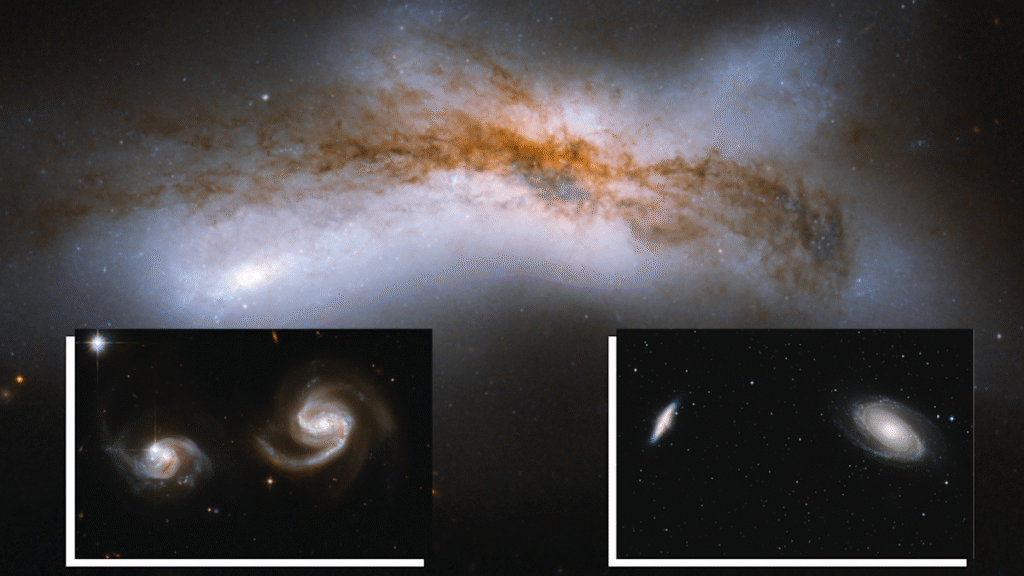When you buy through links on our articles, Future and its syndication partners may earn a commission.

Three future scenarios for Milky Way & Andromeda encounter. Main A 100,000 light-year separation leads to a collision (Bottom left) At 500,000 light-years, dark matter provides friction that brings galaxies to a close encounter. (Bottom right) Galaxies bypass at 1 million light-year separation. | Credit: NASA / ESA
A titanic cosmic collision between the Milky Way and its closest large galactic neighbor, Andromeda, may not be as sure a thing as scientists thought.
Previously, it had been proposed that there was a good chance that Andromeda and our galactic home, which are moving together, would meet in around 5 billion years and merge to form a daughter galaxy dubbed “Milkomeda.”
New research has revealed that there is a much smaller chance that these two spiral galaxies will slam into each other and merge over the next 10 billion years than was believed. In fact, it’s about 50/50.
“Our main finding is that the merger between the Milky Way and Andromeda, which had been predicted to occur in around 4.5 billion years, is actually much less certain. We found only about a 50% chance that this merger will happen during the next 10 billion years,” team leader and University of Helsinki researcher Til Sawala told Space.com. “In short, the probability went from near-certainty to a coin flip.
“I was prepared to find something different, but yes, the fact that there is only around a 50/50 chance of a merger was very surprising.”
Milky Way and Andromeda: Head on collision, near miss or wide berth?
Sawala and colleagues reached this conclusion by simulating the next 10 billion years of the Milky Way’s journey through the universe.
This new simulation was based on updated astronomical data from the Hubble Space Telescope and from the European Space Agency (ESA) star tracking mission Gaia. The team also factored in new estimates of the masses of smaller dwarf galaxies around the Milky Way, which, via their gravitational influence, impact the cosmic passage of the Milky Way.
“The main difference between our research and previous studies is that we benefited from newer and more precise data, and that we considered a more complete system, including the effect of the Large Magellanic Cloud, the Milky Way’s largest satellite galaxy,” Sawala said.

Andromeda and the Milky Way may completely miss each by more than 500,000 light-years, meaning no merger. | Credit: NASA/ESA
The team was able to present different scenarios of what could become of the Milky Way and Andromeda galaxies as they gradually move together.
“A head-on collision is very unlikely, we found a less than 2% chance for that. In most of the cases that lead to a merger, the two galaxies will indeed fly past each other at first, which will lead to a loss of orbital energy, and subsequently to a merger,” Sawala said. “How close they come on their first passage is very uncertain, however, and if they don’t come very close, meaning if their distance is more than around 500,000 light-years, they might not merge at all.”
The researchers found that if the orbits of the Milky Way and Andromeda come close enough for the two galaxies to gravitationally influence each other, then a merger is an eventuality.
“But it’s almost equally likely that they stay well separated, in which case they won’t merge, and also continue to evolve mostly in isolation,”

The Milky Way and Andromeda come close enough to gravitational influence each other without a head-on collision | Credit: NASA/ESA
The team found that while the odds of a merger with Andromeda drop when the Large Magellanic Cloud’s influence is considered, with this adjustment, the Milky Way becomes more likely to cannibalize this satellite dwarf galaxy.
According to this research, our galaxy is almost certain to merge with the Large Magellanic Cloud over the next 2 billion years.
Related Stories:
— Why do dwarf galaxies line up? ‘Zippers’ and ‘twisters’ in the early universe may solve a galactic mystery
— Scientists calculate when the universe will end — it’s sooner than expected
— Amateur astrophotographer captures a stunning galaxy 24 million light-years from Earth (photo)
“Of course, now we really want to find out whether the Milky Way and Andromeda will collide or not,” Sawala said. “That will not only need more observational data, but also more complete modelling of their interaction, as well as of the effect of the environment in which they evolve.
“Luckily, there will be more observational data coming very soon, next year, from the Gaia Space Telescope, and perhaps also from the Hubble Space Telescope.”
The team’s research was published on Monday (June 2) in the journal Nature Astronomy.

